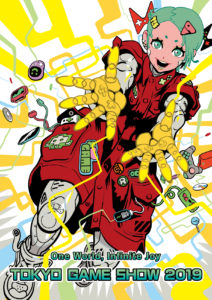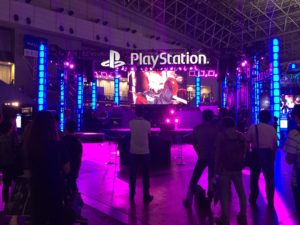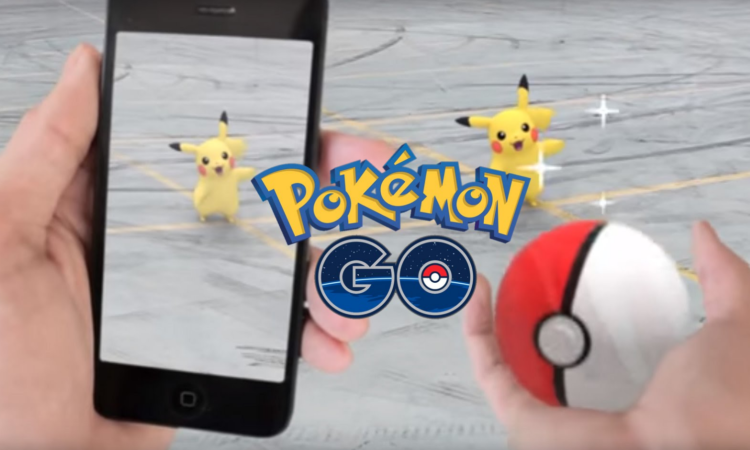
Tokyo Game Show 2019
The Tokyo Game Show is one of the biggest events in the world of gaming. Usually held in the middle of September, the exhibition sprawls over the duration of four days, where the first two are so-called “business days” for media and the gaming industry workers. The latter two days are available to the general public. This year, the Guidable team attended the game show and is ready to tell you about the present and the future of gaming. The Tokyo Game Show coverage will be divided into three parts. The one you are reading right now is the first one. Here I will explain the unique position of the gaming industry in the context of Japanese culture, share my general impression of the exhibition, and cover a few games such as Death Stranding and Cyberpunk 2077.

Gaming Culture in Japan
We already wrote about how games are popular in Japan, but it’s worth mentioning again that Japan has a unique gaming culture. On my way to the show, I could see a lot of people wearing merchandise with game characters (including anime look girls) even though it was a week day. Although the “geek culture” is getting more attention around the world, in many places, including my homeland of Russia, a person wearing this kind of clothing would be considered at least “immature” or “childish.” There’s some social stigma imposed on “otaku” in Japan, but generally video games are a mainstream media just like movies, books, music and etc.
As a relatively new medium, video games have often become the object of criticism, especially from politicians who want to receive some attention by attacking it. In August, President Trump connected video games with the rise of aggression (scientific research proved exactly the opposite). In Russia, official spokeswoman of the foreign ministry blamed videogames for the younger generation’s careless attitudes towards nuclear war. Criticism like this having never occurred in Japan points at the unique position video games have in Japanese society.
Some of the most famous video game publishers and developers started in japan, including but not limited to Sony Computer Entertainment, Bandai Namco, Capcom, Square Enix, Platinum Games, Sega Atlus, and Nintendo. Mario, Legend of Zelda, and Donkey Kong creator Shigeru Miyamoto has received critical and fan acclaim in Japan as well as abroad, as has done Hideo Kojima, the creator of the Metal Gear Solid series and the upcoming Death Stranding.
The Japanese gaming market consists of three parts: home console games, handle games (mobile/portable consoles), and arcades. Today, game publishers in Japan try to release their products on every system available to reach a bigger audience. Unlike western countries, arcade gaming is still doing well in Japan but the upcoming tax hike might damage it since will no longer be “one 50 yen or 100 yen coin experience”.
Japanese companies had struggled with developing games for the latest generation of game consoles after they were released, and it was believed that the Japanese game industry would never catch up to their Western counterparts, but recent successes of previously niche titles such as Persona 5, Yakuza Zero, and Monster Hunter World symbolize the return to power moment for Japan.

General Impressions
As usual, this year Tokyo Game Show was held in the Makuhari Messe complex in Chiba Prefecture. The exhibition consisted of eleven areas where visitors could play games from big and small publishers and buy game merchandise at the official stores. Many visitors could also take pictures of/with booth girls in showcase areas. This year, it was also possible to take a picture of yourself “riding” the bike from Cyberpunk 2077 or Final Fantasy 7: Remake as well as pose with Cloud Strife’s sword. The official press release reports that 262,076 visitors attended the game show this year. Less than last year, but more than 2017.
This year was the first one where I attended the exhibition as part of the “press”. Seeing the photos of huge lines, where people had to wait for at least a few hours to play their favorite game, I felt lucky to try almost everything I wanted to during the business days. Playstation had a very convenient system to try their games. All I needed to do was to register for the game I want to play and receive a special “game ticket” with the time when I could come back to try it. Other companies just made visitors stand in line. I hope that next year, more companies adopt Playstation’s system and pointless waiting will disappear.
What was surprising for me was the lack of games made in Europe or the US. Of course, the show is held mostly for local gamers, but big posters of Doom: Eternal and Fallout 76 at the entrance suggested that they must be playable. In reality, from I saw, only Call of Duty: Modern Warfare and the Medevil remake were available for play. CD Project Red had prepared a big showcase for Cyberpunk 2077 (the one that Keanu Reeves visited) where they were showing 40-minutes demo of the game; Square Enix had a specially designed room with the Avengers costumes but there weren’t any demonstrations of the game. Western publishers often cooperate with the Japanese ones to release their games in Japan, but I would have like to have been able to experience these games rather than just watch promotion only in the form of trailers.
Every big game publisher had its own showcase floor at TGS, often with a big scene where game creators presented their new games. Companies that do not specialize in gaming like Samsung also had large stages where they were presenting games for mobile devices, but despite the size, the crowd during the business days were not so enthusiastic about them, so very few people attended the presentations. Other mobile or free-to-play game developers also tried to attract crowds with loud music and a large number of booth girls.
Besides games, one of the topics of this year’s event was 5G technologies. The company that seems like a pioneer of this technology in Japan, Docomo, also had a large showcase. Indeed, with the proliferation of 5G, the game industry is able to reach a new audience since big games like Final Fantasy or Dragon Quest will be available on mobile platforms without losing any of its looks through streaming. Major players like Playstation and Microsoft are already investing in this field, and are actually cooperating with each other to beat the newcomer, Google with it Stadia. A Docomo representative told me that they are planning to launch 5G in Japan next spring.
Here is something exclusive for our readers: During the event, I met David Cage, the creator of Heavy Rain and Detroit: Become Human. He told me that his next project is already in the making and he hopes that it will take less time to develop than Detroit: Become Human. Recently, Chinese company NetEase bought a major stake in the company to “to develop advanced technologies and games for the future.” Let’s hope they will not make them develop free-to-play Diablo-like mobile RPG.
Death Stranding
After years of speculation on what Death Stranding is about, game director Hideo Kojima finally announced via Twitter that he will present the game’s gameplay during Tokyo Game Show 2019. The reason was the confusion of many gamers who couldn’t understand what kind of game it was that they wanted to buy (this situation tells a lot about what level of credit Kojima has). The director warned the public that if they want to experience Death Stranding in its full glory, it’s better to avoid the presentation. However, the game’s gameplay presentation gathered the biggest crowd that could be seen during the business days.
The protagonist, Sam Bridges (played by Norman Reedus), is delivering four important packages including food, medicine, anti-BT (local monsters) weapons, and sperm and eggs across post-apocalyptic United States to “bring people back together.” All the packages that the player carries or picks up during his or her adventure are visible on the character, therefore, the player must think strategically about what to carry and leave behind.
Sam can scan the environment to see the most dangerous places to avoid. During the demonstration he used this ability to check if the river he was about to cross is safe. At the moment, it seems that the surroundings will be as hostile to the player as the enemies which were shown as well. During action moments, the game looked like the improved version of Metal Gear Solid 5. In compliance with tradition, this segment was played in “stealth mode” without killing anybody. Sam used a special item called “Strand” to tie enemies and “Bola Gun” to do the same from the distance.
One important detail, the main hero always carries “Bridge Baby,” a little fetus in an artificial womb that helps him to see local monsters. This advantage comes at a price: you must care for it. In unfavorable conditions, such swimming for too long in a river with a strong current, the “baby” starts to cry and Sam must soothe it using items he collected by completing side quests.
Speaking of side quests, some NPC that give them to you are designed after real people. The one who was presented during the demonstration was modeled after the famous Japanese singer Daichi Miura. The name of the character is “Musician,” and (surprise, surprise) the item he gives the player is a harmonica.
The game has online functions. Players can leave their equipment in special lockers scattered around the game world to share it with other players around the world. That means that you can put the ladder in the locker, and the player who desperately needs it would be able to take it. Players can also “like” items just as we do on any social media platform. Will Death Stranding have its own influencers? Who knows?
In the second demonstration that was held on Saturday, Kojima showed some other bits of gameplay. Most of it was dedicated to Sam just relaxing in his room, taking selfies, taking a shower, going to the toilet, and drinking beer. Here we can see the evolution of “the base” from Metal Gear Solid 5, and even though it’s just a room, there are more things that are possible to do than in the Kojima’s previous games.
Today, Death Stranding looks like big progress from Metal Gear Solid 5. Let’s hope that this time developers didn’t forget about the story and made some interesting bosses to fight with. Hideo Kojima has always been an artist who concentrates on the universal topics that most people can grasp. This time, it’s possible that he will talk about the current situation in the US, hence all the messages about “bringing people back together.” Do characters live in the post-Trump world? We’ll find out the 8th of November this year.
Cyberpunk 2077
Cyberpunk 2077 is the only western game that had a booth comparable to the Japanese ones. The game wasn’t been available to play, but CD Project Red build a massive “box” which turned out to be a theatre to show the new 40-minute long gameplay demo.
The developers emphasized countless times that Cyberpunk 2077 is an open-world RPG, so it’s natural that they started with the character creation screen that reminded me of the first Mass Effect game. As a player, you can choose gender, abilities, and history of the character. All of these will affect how you play the game and available dialogue options during the conversation with NPC.
In summer the developers announced that Keanu Reeves will appear in the game as a character called Johnny Silverhand. He can only be seen by the player since Johnny is just a hologram living in the protagonist’s head (or at least it looks that way now). He leads you to the leader of the gang called the Voodoo Boys, who asks you to deal with the rival gang, the Animals. The player travels to the point of destination by bike, and on the way, it’s hard to not be amazed by the scale of the city.
Two approaches to gameplay were shown. The first one was emphasis on stealth and hacking abilities. The character killed enemies from behind, hacked turrets to use against them, and in the end, hacked their brains to make them commit suicide. The second one was action-oriented. The wire that was previously used for hacking turned into a wipe, and the character used guns to deal with the enemies. Surprisingly, both approaches looked equally interesting. Another surprise was that unfortunately this time the game does not have graphics as astonishing as imagined, although the attention to details is definitely worth mentioning.
The game looks incredible and I am looking forward to its 16th of April 2020 release. Japan has a love for cyberpunk as a genre, which is why I have no doubt it will be successful in the Japanese market. There’s even homage to the Ghost in the Shell series, with the player hacking enemies by inserting a wire into the opponents’ heads, just like the original manga and anime.
Part 2 coming soon!
Artem // Russia






